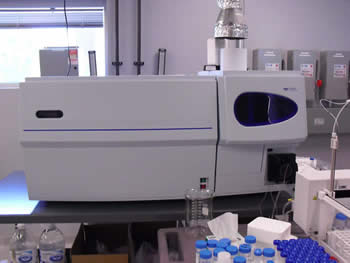The Water Quality Centre (WQC) is located in the Chemical Sciences Building at Trent University in Peterborough, Ontario.
All mass spectrometers are housed in two labs, located just steps away from each other. Argon and nitrogen, used by the mass spectrometers, is supplied through bulk systems that provide the lab with uninterrupted gas supply. There are separate sample prep rooms for organic and inorganic analysis. The inorganic prep room is a Class-10,000 clean room equipped with two Fully Exhausted Polypropylene Vertical Laminar Flow Workstations, providing better than Class-10 conditions, and a Class-100 Laminar Flow Workstation.
Access to the facility is restricted to authorized personnel only. All PCs in the Centre are linked by an Intranet, protected by a hardware firewall, and connected to an automatic backup system.
Mass Spectrometers
A description of our mass spectrometers follows. Each has unique capabilities but is complementary to the others.
For radiogenic and stable isotope analyses (Multicollector-ICP-MS)
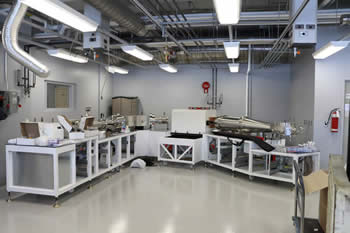
Nu Plasma 1700 MC-ICP-MS
The Plasma 1700 is built to deliver the ultimate performance in MC-ICP-MS analyses. With a 5-ton magnet and occupying a whopping 4 m x 4 m footprint, this behemoth enables the WQC to tackle extremely demanding applications that cannot be performed on other instruments.
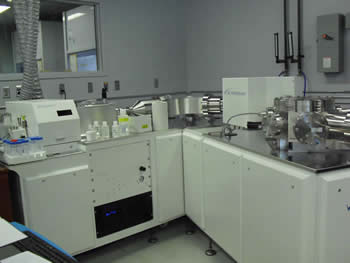 Nu Plasma2 ICP-MS
Nu Plasma2 ICP-MS
The Nu-Plasma-2 (Nu Instruments, UK) is a state-of-the-art MC-ICP-MS instrument, specifically designed for the analysis of isotopic ratios of metal and metalloid elements. The instrument has 16 Faraday collectors and 3 ion-counters, making it the most versatile instrument on the market. It also provides high mass-resolution capabilities to resolve potential interferences in the mass-spectrum.
For trace metal analyses (ICP-MS and ICP-OES)
Teledyne Leeman Prodigy7 ICP-OES
The Prodigy-7 (Teledyne LeemanLabs, US) is a state-of-the-art dual-view ICP optical emission spectrometer (ICP-OES). It offers fast and simultaneous analysis of most elements, with detection limits as low as a few parts-per-billion. The robustness of the ICP and the high dynamic range make this instrument ideally suited for samples with high matrix and element concentrations. In the WQC, this instrument is used to carry out elemental analyses of drinking and waste-waters, soil extracts and dissolved rock samples.
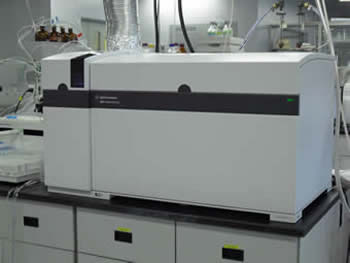 Agilent 8800 Triple Quadrupole ICP-MS
Agilent 8800 Triple Quadrupole ICP-MS
The Agilent 8800 triple quad uses tandem MS configuration (with an additional quadrupole in front of the collision reaction cell) to remove interferences and allow for greater sensitivity and reliability. Elements such as sulphur, phosphorus, chlorine and iodine can be measured with confidence.
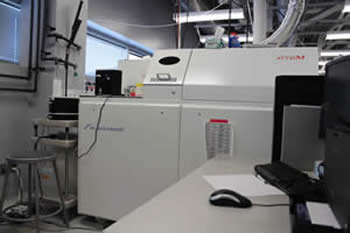 Nu (Attom) High Resolution (HR) ICP-MS
Nu (Attom) High Resolution (HR) ICP-MS
The Attom is a high-resolution magnetic sector ICP-MS and is used to analyse ultra trace level abundances (ppt and lower) of metals. Because of its high sensitivity and the ability to provide flat-topped peaks, it is also extremely well suited for the accurate and precise (+/- 0.1%, 2RSD) determination of isotope ratios, such as Pb, even for samples that contain as little as 0.1 ppb Pb.
For emerging organic contaminant analyses (LC-MS/MS & GC-MS)
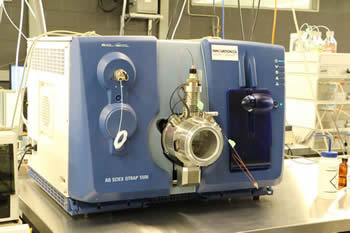 Applied Biosystems (QTrap 5500) LC-MS/MS
Applied Biosystems (QTrap 5500) LC-MS/MS
The Qtrap 5500 is the most sensitive organic mass spectrometer in the WQC. Operated in multiple reaction monitoring (MRM) mode, this hybrid triple quadrupole linear ion trap is the go-to instrument for quantitation of trace organic contaminants (such as pharmaceuticals, personal care products, plant hormones) and targeted metabolomics. When using the linear ion trap (LIT) this instrument has MS3 capabilities and can be used to assist for structural identification of unknowns. This instrument is equipped with both turbo ion spray and atmospheric pressure chemical ionization (APCI) sources and can be coupled with both liquid and ion chromatography instruments.
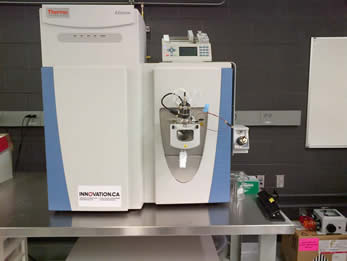 Thermo (Q Exactive) Quadrupole-Orbitrap LC MS/MS
Thermo (Q Exactive) Quadrupole-Orbitrap LC MS/MS
The Thermo Q Exactive combines quadrupole precursor ion selection with high-resolution, accurate-mass Orbitrap detection. It is also equipped with a Mass Tech AP MALDI source. It is useful for untargeted or targeted screening and a broad range of qualitative and quantitative applications in drug discovery, proteomics, environmental and food safety, clinical research and forensic toxicology.
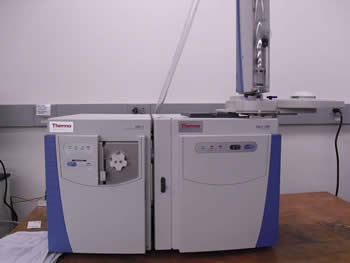 Thermo ISQ Trace 1300 GC-MS
Thermo ISQ Trace 1300 GC-MS
The Thermo GC-MS is composed of a Trace 1300 gas chromatography instrument and an ISQ single quadrupole mass spectrometer and is ideal for routine qualitative and quantitative analysis of volatile compounds. It is equipped with both electron (impact) ionization and chemical ionization, a large volume injection port capable of injections up to 5 mL and a 155 vial autosampler.
For molecular high resolution analyses (FT-ICR-MS)
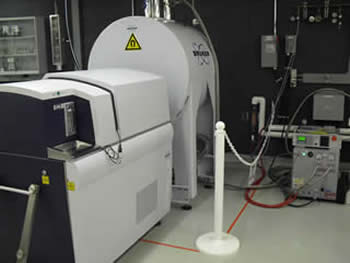 Bruker (SolariX-XR)
Bruker (SolariX-XR)
First one in Canada!
The Bruker SolariX XR (eXtreme Resolution) is a Fourier Transform – Ion Cyclonic Resonance (FT-ICR) mass spectrometer equipped with a 7 T magnet. This instrument is capable of up to 10 million resolution and provides the user access to chemical information, including isotopic fine structure and mass accuracy (< 100 ppb) that was previously inaccessible. A wide variety of applications is possible including complex environmental sample and petroleum product analyses, proteomics studies and metabolomics research.
For traditional stable isotope analyses (CF-IRMS and GC-IRMS)
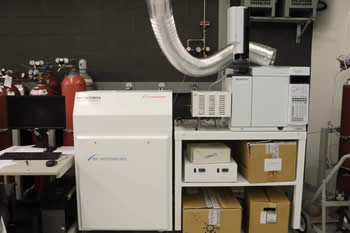 Nu Horizon CF-IRMS
Nu Horizon CF-IRMS
he Nu Horizon continuous flow isotope ratio mass spectrometer, coupled with a Eurovector elemental analyzer allows us to carry out stable carbon and nitrogen isotope measurements of solids. These data can be used for ecology, archaeology, palaeontology, environmental forensics, and a range of other fields.
Decommissioned instruments
- Thermo Finnigan (Element2) ICP-MS
- Thermo Finnigan (Neptune) MC-ICP-MS
- Thermo (XSeries2) ICP-MS
- Varian (820) ICP-MS
- Micromass (Q-Tof-2) LC-MS/MS
- Micromass (Quattro) LC-MS/MS
- Applied Biosystems (Q-Trap) LC-MS/MS
- Applied Biosystems (API 3000) LC-MS/MS
- Varian (Saturn 2200) GC-MS/MS
- Micromass (Isoprime) CF-IRMS
Other instrumentation
In addition to the mass spectrometers, the WQC also possesses:
- Dionex Accelerated Solvent Extractor
- Sartorius SE2 microbalance
- Brooks Rand MERX Automated MeHg Anlayser
- LGR (Los Gatos Research) LWIA (Liquid Water Isotope Analyser) 24d
- 2 DSL (Delta Scientific Laboratory) Sub-Boiling Stills
- Ethos EX Microwave Extraction System
- APEX and ARIDUS desolvators for sample introduction
- the ability to carry out various separation techniques including:
- ion chromatography (IC)
- liquid chromatography (HPLC) as well as a preparative chromatography system
- hydride generation (HG


